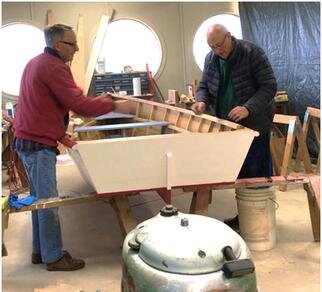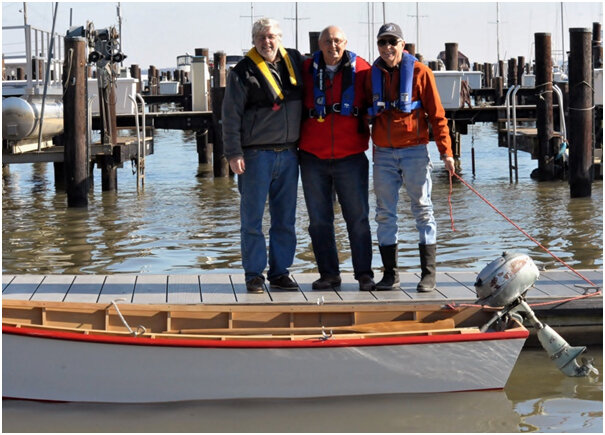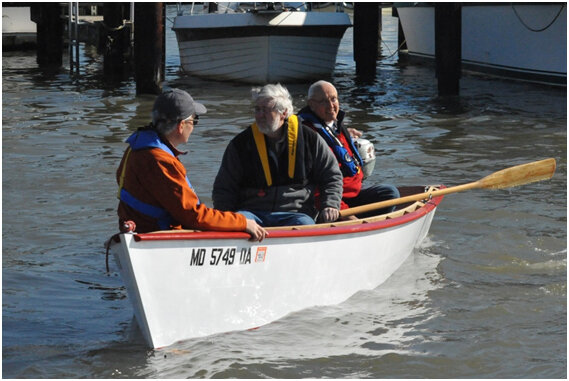Boat Shop Completes Chesapeake Bay Fishing Skiff
Builders Bruce Russell, Cecil Shook and Al Caffo
In December of 2016, we completed a 15’ Chesapeake Bay fishing skiff. The boat was launched on January 25, 2017, marking the completion of this volunteer project at the Havre de Grace Maritime Museum’s boat shop.
The boat was built from plans for a Chesapeake Bay skiff, taken from a Mechanics Illustrated magazine, circa 1955. The article begins with, “When the soft southerly breezes blowing on your fevered brow and the moist, salty tang of marshes tingle in your nostrils make you long to get out on the water, then, Brother, the bug has bitten you and it’s time to consider building a boat. Chessy is just the ticket…”. The volunteers quickly “got the bug”, meeting weekly to work through the detailed drawings.
The plans call for cedar and oak construction, with galvanized nails for assembly, but some substitutions were made by the museum volunteer builders. Poplar boards replaced cedar for the boat side planks, as long, wide and clear planks are much harder to find now, and decking screws provide much more strength and corrosion resistance, compared to nails. Some plywood was substituted for boards used in seats and the boat bottom, as well.
While the plans were quite specific, the museum builders were often skeptical that wood could be convinced to bend and twist in the way the instructions suggested. These were exciting times, as wood popped and groaned under the stresses of assembly, but the plans proved to be accurate and the boat came together as promised.
Side planks were pulled in against a temporary frame, then oak ribs were attached by Cecil Shook, as shown below. The sides were then attached to the oak transom (back side) to complete the hull. With the boat turned over, all the wooden parts were faired (smoothed) to allow a snug fit of the boat bottom.
Below: Two Marine-grade plywood panels were scarfed (joined together) to form the boat bottom. The plans (foreground) then called for lengthwise oak supports to be added and seats fitted. Paint colors depended on what was available in the shop, resulting in white sides, red bottom and trim and gray seats and bottom interior. The interior wood was rubbed with preservative.
Left: “Shop clothes” were worn by volunteers Al Caffo and Abe Spergel, knowing that generous coatings of sawdust, paint spots, and stains are inevitable. The donated outboard engine (foreground) is a 5 HP Johnson SeaHorse model from 1949. While short on options, it ran reliably after just a minor tune-up.
With the wood work, painting and engine testing complete after about a year of once-a-week sessions, the boat was ready to launch. An unseasonably warm day in January provided the opportunity. The boat was successfully rowed away from the launch dock. After some fiddling with the outboard by Abe Spergel, the engine purred into action for a tour around the Susquehanna Flats around Concord Point Lighthouse and Tydings Park. With no water leaks evident and the boat safely back at the dock, the crew declared the project to be a grand success.
It is safe to say that the promise made in the 1955 “Build Chessy” article that you can get bitten by the bug to build a boat has proved correct. Even after more than 60 years, the collection of museum volunteers has found this project to have been an incredibly rewarding experience, rich in camaraderie, local history and the gratification of making a functional wooden vessel by hand.













